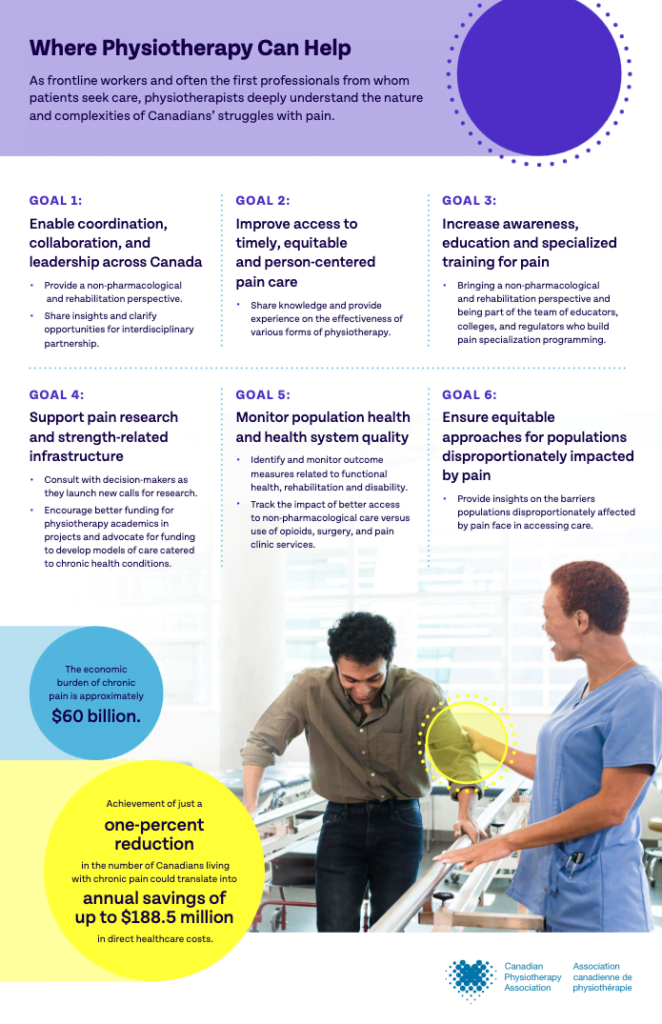Living with chronic pain can be an isolating and debilitating experience. The pain can interfere with your daily activities, impact your mood and cause sleep disturbances. According to a Canadian Pain Task Force Report, almost 8 million people (1 in every 5) in Canada suffer from chronic pain.
Fortunately, there are treatments available that can help manage symptoms and provide relief.
In this blog post, we’ll dive into what chronic pain is, different types of chronic pain, and how physiotherapy can help.

Source: Canadian Physiotherapy Association
What is Chronic Pain?
So, what is chronic pain? Chronic pain is defined as pain that lasts for over 12 weeks. Unlike acute pain, chronic pain may continue even after the initial cause of the pain is resolved.
Causes of Chronic Pain
Chronic pain can be caused by many factors, including old injuries, nerve damage, inflammation, poor posture, stress, and even genetics.
It is important to understand that chronic pain is not just a physical issue; it affects your lifestyle, relationships, sleep, and overall well-being. Coping with chronic pain can be challenging, but there are ways to manage and reduce the pain.
Types of Chronic Pain and Their Symptoms
Chronic pain can stem from different sources and present itself in various forms such as back pain, headaches, arthritis, and nerve pain. Some of the more common types of chronic pain include:
- Chronic Back Pain: Persistent pain in the lower back caused by herniated discs, degeneration of spinal discs or sciatica. Symptoms range from dull aching to sharp stabbing pain that radiates through the spine or even down the legs.
- Migraines: Intense headaches often accompanied by nausea, vomiting and sensitivity to light, sound and smell. This type of chronic headache can last for hours or even days at a time with varying levels of intensity.
- Fibromyalgia: Characterized by widespread muscle and joint pain, fatigue and sleep disturbances. Other symptoms may include headaches, anxiety, depression and digestive issues.
- Arthritis: Caused by inflammation of one or more joints which can lead to joint pain and stiffness as well as reduced mobility.
- Neuropathic Pain: Caused when nerves become damaged or irritated resulting in burning, tingling or numbness sensations in the affected areas. This type of pain is often described as an electric shock or tingling feeling.
- Myofascial Pain Syndrome (MPS): A disorder characterized by intense tender points throughout the body which can lead to painful muscle knots known as trigger points that cause localized pain as well as referred pains in other parts of the body such as head, neck and shoulders.

Source: Canadian Physiotherapy Association
The Role of Physiotherapy in Assisting Patients with Chronic Pain
The role of physiotherapy in treating chronic pain is to help patients restore their mobility, reduce pain, and improve their overall function. Treatment plans focus on reducing inflammation, improving strength and flexibility, and addressing imbalances that may be contributing to the pain.
Physiotherapists are uniquely trained to offer non-pharmacological, evidence-based care to those suffering from chronic pain. Some of the physiotherapy techniques that can be used to alleviate chronic pain include:
- Exercise therapy to improve mobility and flexibility
- Manual therapy to reduce pain and stiffness
- IMS to relieve pain and reduce inflammation
- Massage therapy to improve circulation and reduce stress
- Education re: optimal postures, understanding pain science, things to avoid, and stress management
Each technique is chosen based on the individual patient’s needs, taking into account medical history, lifestyle factors, goals and preferences in order to develop the most effective treatment plan possible.

Benefits of Physiotherapy for Chronic Pain
Physiotherapy offers many benefits for those who suffer from chronic pain, including:
- Improved physical function
- Reduced pain and inflammation
- Improved sleep quality
- Lowered stress levels
- Improved mental health
- Decreased risk of further injury
It’s important to note that physiotherapy alone is not the only solution to managing chronic pain. A holistic approach that involves self-care and lifestyle changes is also necessary. This may include proper nutrition, stress management, and regular exercise. It is also important to consider collaboration with other healthcare professionals to support the patient’s holistic health and well being.
Don’t Just Live with Chronic Pain
Living with chronic pain can be challenging, but there are ways to manage and reduce the pain.
Physiotherapy is a highly effective and non-invasive way to alleviate chronic pain and restore your quality of life. If you are dealing with chronic pain, consider reaching out to us at Reformotiv Physio + Pilates for personalized care and treatment.
Don’t suffer in silence – there is hope for chronic pain relief and bringing ease back to your daily life. We would love to help you get back to doing the things that bring you joy! Contact us today.

